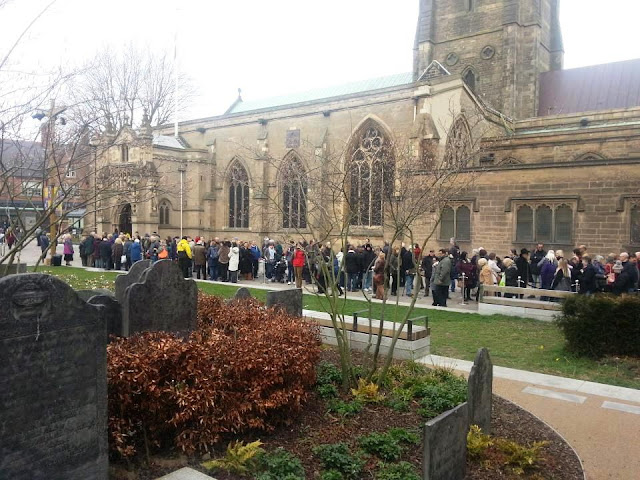 |
The queue to file past Richard III's coffin passes the old song school on its way to the cathedral entrance |
Archaeologists excavating the site of the old song school at Leicester Cathedral have discovered what is believed to be a Roman shrine, reports the Leicester Mercury:
The cellar of a Roman building and a 1,800-year-old altar stone have been discovered during the excavation of the site where the choir would have been practised and rehearsed, led by University of Leicester Archaeological Services (Ulas), suggesting the presence of a shrine or cult room. The cellar – now nearly 10ft (3m) below the ground – is believed to have had a concrete floor and stone walls, with decorative paintwork.
The Mercury goes on to quote the leader of the dig, Matthew Morris - its story gives his age but not his first name:
"It could be really significant. It’s an area of Leicester that we don’t get to excavate very often.
"It’s the historic quarter of the town, so it’s one of those big blank areas on the map of the city. But it’s also quite fundamental in understanding the history of Leicester Cathedral.
"Whilst it’s an iconic building in the cityscape, we don’t actually know too much about its early history and most of what you see above ground today was rebuilt in the Victorian period. So an excavation next to it was really the only way we were going to get to grips with key questions, like when was it first founded, and what was underneath it before?
"There’s always been this folk tale that there was a Roman temple underneath the cathedral. Until now, there’s been no way of being able to say whether there was or not, but we’re certainly looking at, with this excavation and the discovery of this cellar and the fragment of a Roman altar stone out of it, that there is definitely a Roman place of worship underneath the cathedral.”
The dig, which has been made possible by the demolition of the song school in the second round of alterations following the internment of Richard III in the cathedral, has also found a Saxon coin and what may be signs of the first building of that period to be found in this part of the city.
And sometimes folk tales do turn out to be true. I remember reading of an old lady who grew up in a house in Friar Lane who was told as a girl that there was a king buried in the back garden. The house backed on to the site of the Franciscan friary where Richard III was found.
It's all a reminder of what a historic city Leicester is. "Where will be be buried? Presumably not in Leicester," asked Kirsty Wark after Richard was found. Be off with you, madam.
No comments:
Post a Comment